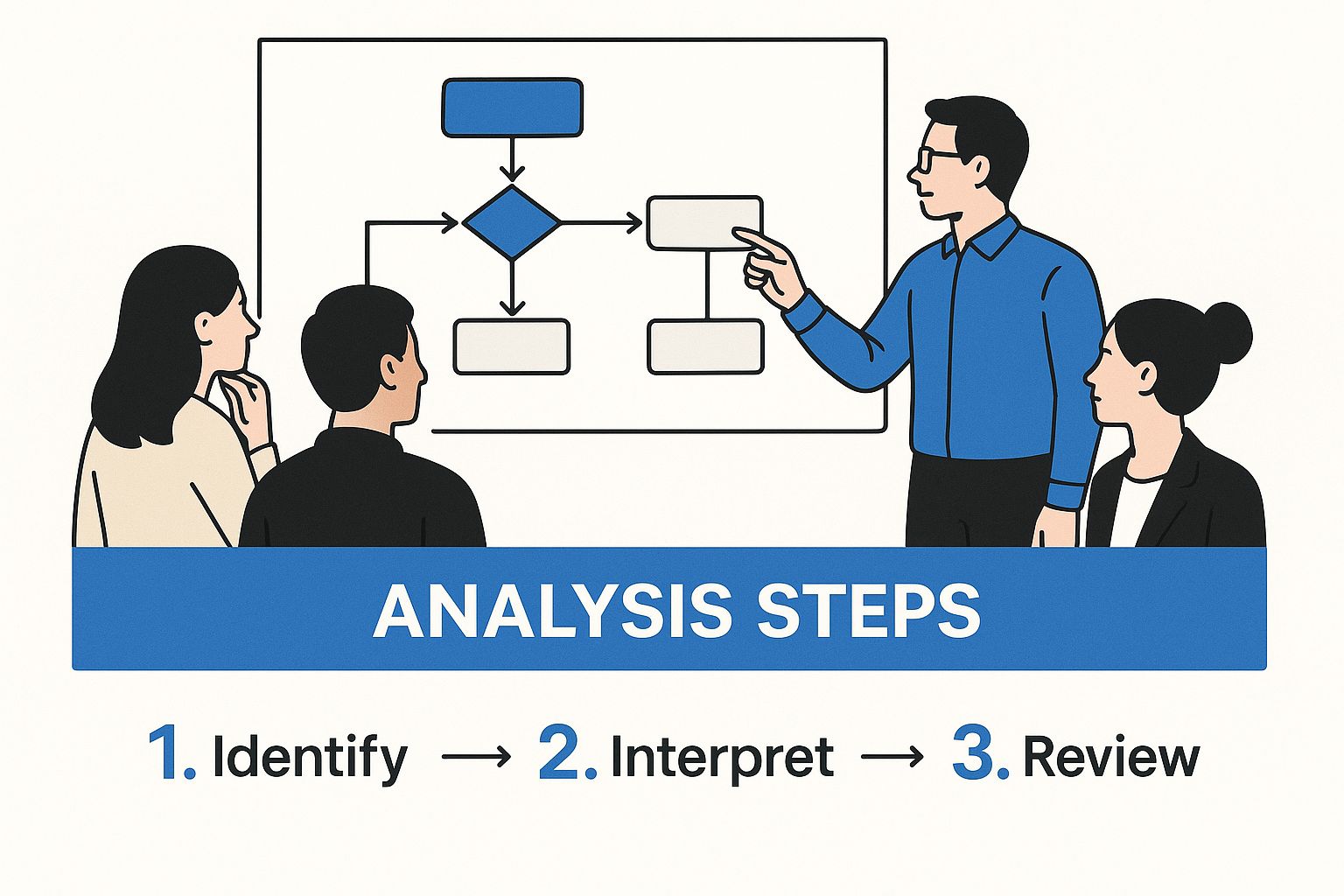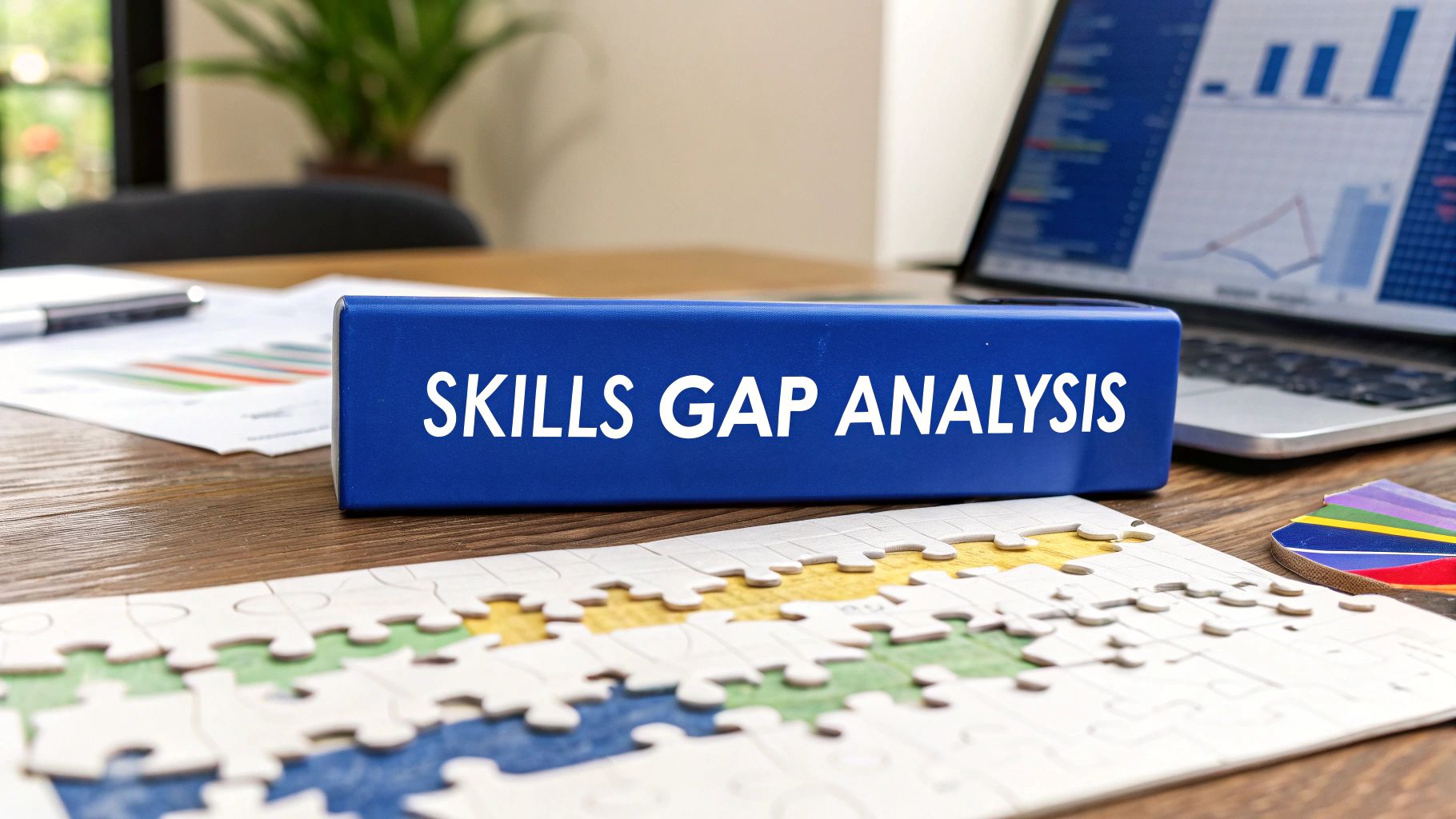A skills gap analysis is a method for figuring out the difference between the skills your company needs to hit its goals and the skills your workforce actually has right now. Think of it as drawing a map. It shows you where your team's capabilities are today and, more importantly, where you need them to be for the future. This map becomes your guide for making smarter decisions on everything from hiring and training to overall business growth.
Understanding the UK’s Growing Skills Divide
Let’s use an analogy. Imagine your business is a high-performance race car, engineered to win. The problem? You’re missing a mechanic who knows how to work on the new hybrid engine technology that all the top teams are using. You have the ambition and a brilliant vehicle, but a critical skills deficit is stopping you from even competing. That's the reality for a huge number of UK businesses today.
The term ‘skills gap’ perfectly describes this growing mismatch between the abilities employers are desperately looking for and what’s available in the workforce. This isn't just a bit of HR jargon; it's a serious economic hurdle. A recent survey of 2,000 UK hiring managers found that a staggering 76% are struggling to fill job vacancies because of this gap. The outlook isn't great either, with forecasts suggesting this misalignment could cost the UK £120 billion in lost output by 2030. You can explore more data on this economic impact to see how different sectors are affected.
Visualising the Skills Mismatch
To really get a handle on this, it helps to see how various economic and tech-driven forces are creating these gaps in the first place.

As the diagram shows, skills gaps don't just appear out of nowhere. They're the result of several overlapping pressures, from the relentless pace of new technology to major shifts in global market demands. A skills gap analysis is what helps your organisation get ahead of these challenges.
A skills gap analysis moves your organisation from being reactive to proactive. Instead of scrambling to find talent when a need becomes critical, you can anticipate future requirements and prepare your workforce well in advance.
At its core, running this kind of analysis gives you a few major advantages:
- Strategic Workforce Planning: It helps you connect your talent strategy directly to your biggest business goals.
- Targeted Training Investment: You can put your training budget to work developing the exact skills you need, so you stop wasting money on programmes that don't deliver.
- Improved Employee Retention: When you invest in your people’s development, you show them you're committed to their careers, which naturally boosts morale and loyalty.
By systematically finding and closing these gaps, your business can build a team that’s more resilient, adaptable, and genuinely ready for whatever challenges come next.
The Strategic Impact of Closing Your Skills Gap
Think of a skills gap analysis as less of an HR exercise and more of a strategic business tool. It’s about getting ahead of the curve. Instead of constantly reacting to problems as they pop up, you get a clear roadmap for building a team that’s ready for what’s next, not just what’s happening today.
The most immediate change you’ll see is in your hiring. You stop recruiting out of urgent, vague needs and start targeting candidates with the exact skills that will push your company forward. This means new hires can hit the ground running and fit perfectly into your long-term vision.
Sharpening Your Focus and Budget
This kind of analysis also brings incredible clarity to your training budget. You can stop spending on generic courses and instead pour resources into programmes that fix specific, identified weaknesses in your teams. It’s a smarter way to spend money, and it does wonders for morale.
When people see a direct investment in their own career growth, their loyalty and motivation skyrocket. This is where targeted upskilling initiatives come in; they’re a powerful way to show your team you’re committed to their journey. Unsurprisingly, employees who feel valued and see a clear path for advancement are far less likely to look for work elsewhere.
By understanding the precise skills landscape of your organisation, you can build a more resilient and adaptable workforce. This knowledge is the foundation for creating a team that can confidently navigate market shifts and technological changes.
Finally, this whole process makes succession planning so much smarter. When you know the strengths and development areas of every single person, you can spot and groom future leaders from within your own ranks. This builds a strong internal talent pipeline, making you less reliant on expensive and time-consuming external searches for critical roles.
By methodically working through the findings of your skills gap analysis, you end up with a team that is not only highly capable but also completely aligned with your company’s goals. That’s a real competitive advantage, turning your workforce into a well-oiled machine ready for anything.
A Step-by-Step Guide to Your First Skills Gap Analysis
Right, let’s move from theory to action. This is where a skills gap analysis really starts to pay dividends. To keep things from feeling overwhelming, we can break the whole thing down into a practical, four-stage framework. Following these steps ensures you move logically from your big-picture goals right through to a concrete plan.
The infographic below gives you a bird's-eye view of these core stages. You can see how each step naturally flows into the next, building a complete picture.

As you can see, a successful analysis isn't a one-off task. It’s a cycle that starts with strategic planning and ends with targeted action, creating a feedback loop for continuous improvement.
To help you get started, this table outlines the entire process at a glance.
Four Key Stages of a Skills Gap Analysis
Now, let's explore what each of these stages looks like in practice.
Stage 1: Define Your Future Goals
Before you can even think about measuring skills, you need a clear destination in mind. Where is the business headed in the next one, three, or even five years? Are you planning to break into new markets, adopt a new piece of tech, or launch a game-changing product?
Once that vision is crystal clear, you can start working backwards to identify the specific skills needed to make it a reality. For instance, if your big goal is to expand your e-commerce operations, you’ll obviously need top-notch skills in digital marketing, data analytics, and the latest customer relationship management software.
The most crucial first step is to connect your talent needs directly to your business strategy. Without this link, any analysis will lack direction and fail to address the skills that will actually drive future growth.
Stage 2: Measure Your Current Team Skills
With your future needs mapped out, it's time to take stock of what you already have. This is the data-gathering phase, where you create an accurate inventory of the skills your team currently possesses. It’s vital to use a few different methods here to get a well-rounded view and sidestep any potential bias.
You can build this picture using a mix of techniques:
- Self-Assessments: Ask employees to rate their own proficiency in key areas. This often uncovers hidden talents and gives you a peek into their personal career goals.
- Manager Evaluations: Line managers are on the ground every day; their insights into their team's performance and skill levels are invaluable.
- 360-Degree Feedback: Getting input from peers, managers, and direct reports offers a much more holistic view of someone's capabilities.
- Skills Testing: For technical roles, nothing beats objective proof. Practical tests or certifications provide clear evidence of proficiency.
Stage 3: Analyse the Difference
This is the heart of the analysis. You’re simply comparing the list of skills required for your future goals (Stage 1) with the inventory of skills your team has today (Stage 2). That difference between the two? That’s your skills gap.
It helps enormously to visualise this data. A skills matrix or even a simple spreadsheet can map individual employees or entire teams against the necessary skills. Using a scoring system (e.g., 1-5, from novice to expert) is a great way to highlight where the most significant shortfalls are.
This analysis will quickly reveal critical patterns. You might find a widespread weakness in a single area, like data security, or realise a key department is missing the leadership skills needed for a big upcoming project.
Stage 4: Create an Action Plan
Identifying the gaps is only half the battle. The final, and most important, stage is creating a realistic plan to close them. Your action plan needs to outline specific, measurable, and time-bound steps to resolve the skills deficiencies you've uncovered.
Your plan will likely involve a blend of strategies:
- Training and Development: Implement targeted programmes to upskill your existing employees.
- Strategic Hiring: Go out and recruit new talent to bring in critical skills that are missing entirely.
- Mentorship Programmes: Pair less experienced staff with your senior experts to encourage knowledge transfer.
- Process Redesign: Sometimes, you can simply adjust a workflow to make better use of the skills you already have.
Documenting every step is the key to making this work. To help structure your findings and build a clear roadmap, you can use a comprehensive skills gap analysis template that guides you through recording your goals, current skills, identified gaps, and proposed solutions. This is how you make sure your analysis translates into meaningful, lasting change.
Choosing the Right Tools to Measure Employee Skills
To get a skills gap analysis right, you need to measure things accurately. It's the foundation of the whole process. Without the right tools, you're just guessing, and your strategy will be built on shaky ground. The aim is to get a clear, honest picture of your team's current capabilities.
Relying on a single source of information, like a manager's opinion, is a recipe for a skewed perspective. It often introduces bias and leaves you with an incomplete jigsaw puzzle. A much better approach is to blend different methods—combining subjective, human insights with objective, hard data. This gives you a far more reliable and complete inventory of the skills you actually have in-house.
Combining Subjective and Objective Methods
To get that complete picture, you need to mix and match your assessment techniques. Each method gives you a slightly different angle on an employee's skills, and when you put them all together, you get a well-rounded view you can actually trust.
Some of the most common approaches include:
- Manager Evaluations: Your line managers are on the front line. They see their team members in action every day and have a real sense of their strengths and where they need to develop.
- Self-Assessments: It’s amazing what you can uncover by simply asking people to rate their own skills. It often brings hidden talents to light and gives you insight into their career goals, encouraging them to own their development.
- 360-Degree Feedback: This is where you gather anonymous feedback from an employee's peers, direct reports, and managers. It provides a fantastic, holistic view of how they collaborate and interact with others.
These methods are brilliant for understanding behaviours and on-the-job performance, but they work best when balanced with more objective data. For a deeper dive, our guide on how to measure employee performance breaks down practical frameworks you can use.
Using Technology for Accuracy and Scale
For larger companies, or when you're trying to assess highly technical skills, doing everything manually just isn't practical. It quickly becomes slow, clunky, and inconsistent. This is where specialised software can be a game-changer, helping to automate the process and keep everything standardised.
By 2030, up to 20% of the UK workforce could be significantly underskilled, a reality driven by the rapid adoption of automation and AI. This makes efficient and scalable skills measurement more critical than ever for maintaining productivity and economic growth. You can read the full research about these productivity risks to understand the national context.
Modern platforms can seriously speed up your analysis. When you’re looking for the right solutions, exploring the top competency assessment tools can make a huge difference to the accuracy and efficiency of your entire project.
Here are a couple of tech solutions to consider:
- Skills Testing Platforms: These platforms offer standardised tests that objectively measure how proficient someone is in a specific skill, whether it's a programming language, a piece of software, or even creative design. They take the guesswork out of it and give you clean, comparable data.
- Competency Mapping Software: This kind of software helps you build a central skills database for your whole organisation. You can map employee skills against the needs of specific roles and your future business goals, making it much easier to see the gaps at an individual, team, or even company-wide level.
By bringing together human insight from evaluations and the hard data from technology, you can build a truly robust picture of your team's real abilities. This is the solid foundation you need for an analysis that actually leads to meaningful change.
How Skills Gaps Are Reshaping UK Industries
The skills gap isn't some vague business theory; it's a real force actively changing the face of entire sectors across the UK. To get a proper handle on its impact, we need to look past the abstract concepts and see the tangible consequences playing out on the ground, from our world-leading tech hubs to the foundational pillars of our economy.

This is precisely why a skills gap analysis is so vital. It helps organisations see these shifts not as distant thunder but as immediate challenges that demand a smart, strategic response. By pinpointing exactly where the shortfalls are, companies can adapt before they get left behind.
The Tech Sector's Constant Chase
Nowhere is the skills gap more obvious than in the technology sector. The pace of change is relentless, meaning today’s must-have skill could be yesterday's news tomorrow. It leaves UK tech firms in a constant race to catch up, scrambling to find professionals with very specific, high-demand expertise.
A few key areas are feeling the pinch:
- Cybersecurity Analysts: As digital threats grow more complex, the need for experts who can protect valuable data has gone through the roof. The problem is, the supply of qualified people hasn't come close to matching that demand.
- Data Scientists and AI Specialists: Businesses are drowning in data, but many lack the in-house talent to make sense of it all and build predictive models. This gap directly throttles their ability to innovate and make sharp, data-backed decisions.
A focused analysis shows just how serious this is. The demand for data engineers (30%) and Python engineers (25%) points to a critical shortage in the programming and AI infrastructure skills that underpin modern tech. You can read more about how these digital skills gaps are affecting UK industries in 2025.
Traditional Industries Facing New Demands
It’s not just tech companies feeling the strain. Traditional sectors like manufacturing, healthcare, and logistics are also in the middle of a massive shake-up, creating an urgent need for completely new sets of skills. These industries are at a crossroads where old-school knowledge has to merge with modern capabilities.
The real challenge for established industries is not just adopting new technology, but cultivating the human skills required to operate it effectively. Without a skilled workforce, even the most advanced tools are rendered useless.
Take manufacturing, for instance. The rise of automation and "smart factories" requires a workforce skilled in robotics, data analytics, and machine maintenance—not just traditional assembly line work. In the same way, the NHS and private healthcare providers are rapidly adopting digital health platforms and telemedicine, creating a sudden demand for staff with IT, data security, and virtual patient management skills.
Even sectors like transport and construction score very low on the Automation & AI Readiness Index, revealing a significant lag in preparing their workforces for the changes already happening. It just goes to show that conducting a skills gap analysis is no longer a choice but a necessity for survival and growth in every corner of the UK economy.
Common Questions About Skills Gap Analysis
Once you start thinking about putting skills gap analysis to work in your own company, a few practical questions always pop up. Getting these details right is what turns a good idea into a powerful, repeatable process that actually helps your business.
Let’s walk through some of the most common queries I hear. Getting these sorted will help you sidestep the usual pitfalls and get real value from your efforts.
How Often Should We Do This?
There's no single magic number, but a good rule of thumb is to run a full, deep-dive analysis at least once a year.
Why annually? Because it slots in perfectly with your yearly strategic planning and budgeting. This way, your training and hiring plans aren’t an afterthought—they're woven directly into the business goals for the year ahead.
Now, if you're in a fast-moving industry like tech, finance, or digital marketing, things change quickly. In those cases, a lighter "pulse check" every six months is a smart move. The skills that are vital today could be old news tomorrow.
You'll also want to run an analysis whenever something big happens in the business. Think of major events like a digital transformation project, a merger with another company, or even expanding into a new country. Moments like these completely redefine the skills your team needs to win.
Treat your skills gap analysis like a regular health check for your company's talent. It’s not a one-off project; it’s about catching potential problems early before they turn into major roadblocks.
What's the Difference Between a Skill and a Competency?
This is a great question, and it's one where people often get tangled up. The two terms are used interchangeably all the time, but they're not the same thing. Nailing the difference is crucial for a sharp, effective analysis.
A skill is the ‘what’. It’s the practical ability to perform a specific task. You can see it, measure it, and usually teach it pretty directly. Think of things like coding in Python, using Salesforce, or speaking fluent German.
A competency is the ‘how’. It's much broader and describes how someone combines their knowledge, skills, and personal attributes to succeed. Competencies are things like ‘strategic thinking’, ‘leadership’, or ‘customer focus’. They’re about applying skills effectively.
A skills gap analysis usually zeroes in on those specific, teachable skills. A competency analysis, on the other hand, looks at the bigger-picture qualities that define top performers, especially in leadership roles. Both are vital for effective talent management and organisational growth, giving you a complete picture of your workforce.
What Are the Biggest Mistakes to Avoid?
Knowing where others have gone wrong can save you a world of pain and make sure your analysis actually leads to change.
Here are the top three stumbles I see people make:
- Only looking at today’s needs. An analysis that just focuses on the here and now is out of date the second you finish it. You absolutely have to tie it to your future business goals. You're building a team for where you're going, not just for where you are.
- Relying on a single source of truth. Just using manager reviews, for example, is a recipe for bias. The best analyses always pull from multiple places—self-assessments, 360-degree feedback, performance data, and objective skills tests—to get a well-rounded, honest view.
- Forgetting to create an action plan. This is the cardinal sin. All that data is meaningless if it just sits in a report. The analysis is just the diagnosis; the real value comes from the treatment plan—the training, hiring, and mentoring you put in place to close the gaps you’ve found.

